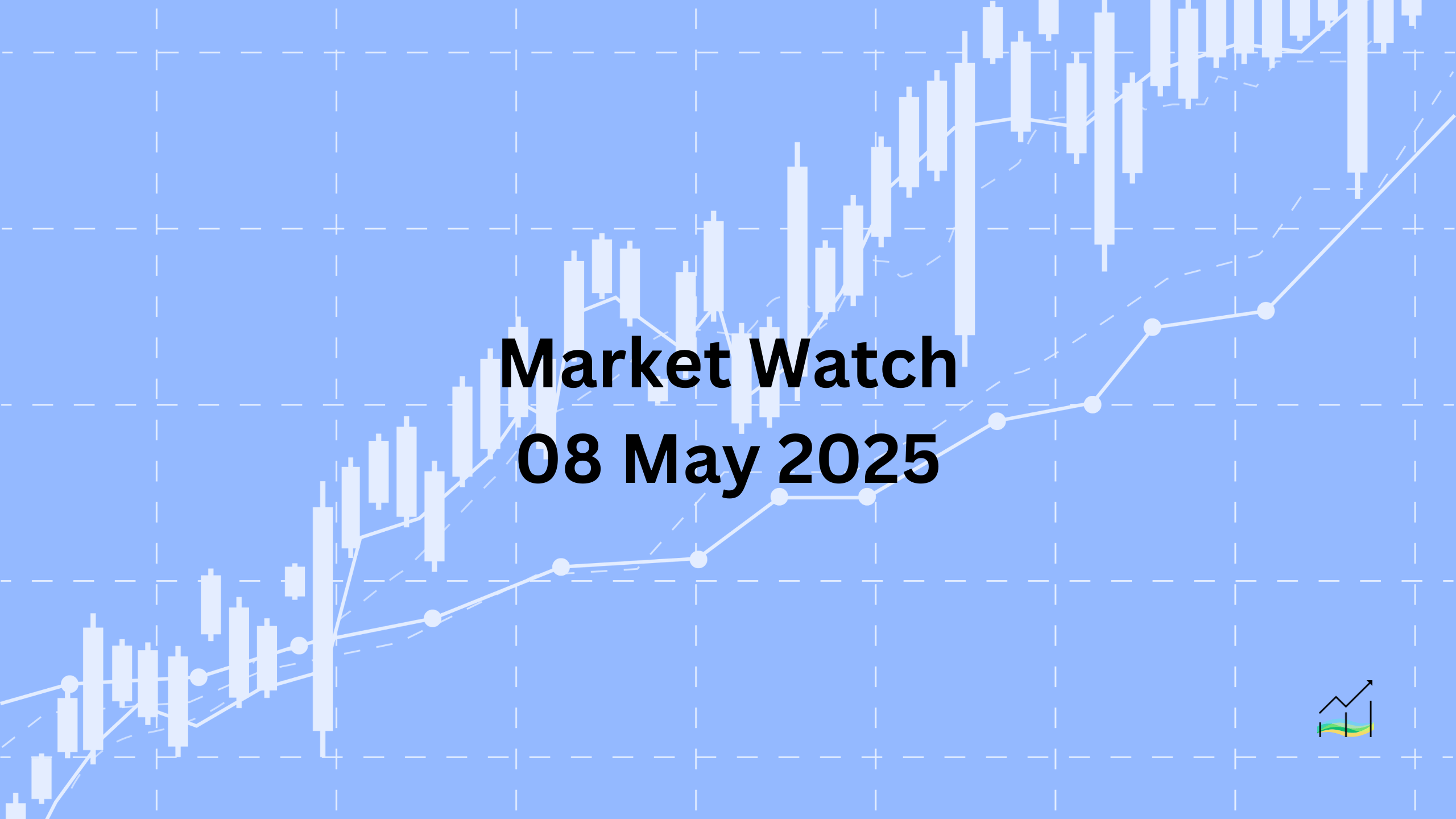08/05/2025 Market Watch

US-China Tension, U.K. Trade Deal as Dollar Extends Gains
Key Takeaways:
- US-China talks face uncertainty, with disputes over who initiated them.
- A US-UK trade agreement is expected today, but it hasn't lifted sterling ahead of a likely BOE rate cut.
- The US dollar continues to strengthen following the Fed’s hawkish stance.
- Equities are mostly firmer globally, though some Asian markets are under pressure.
- Bond yields are rising, gold is falling, and oil is approaching recent highs.
Markets are bracing for the upcoming US-China talks, though tensions are already flaring with each side disputing who requested the discussions. This clash of egos risks a downgrading—or even cancellation—of the meeting. Given the tone, expectations for any meaningful progress are already low.
Meanwhile, a new trade agreement between the US and the UK is expected to be announced today. However, this development has not stopped sterling from declining ahead of the Bank of England’s policy decision, where a dovish quarter-point rate cut is widely anticipated. The pound remains under pressure as traders position cautiously in advance.
The US dollar is gaining further ground, bolstered by the Federal Reserve’s hawkish hold. It is stronger across the G10 complex and against most emerging market currencies, signaling continued confidence in US monetary policy divergence.
Global equities are showing resilience, with most markets advancing. Notable exceptions are India and Pakistan, where declines have been sharper, particularly in Pakistan’s case with a 6.8% drop. In Europe, the Stoxx 600 is rebounding after a two-day slide, supported by a more than 1% rally in Germany’s DAX, fueled by a 3% rise in industrial production. US equity futures are also pointing higher.
Bond markets are under pressure, with yields climbing in both Europe and the US. The 10-year US Treasury yield is above 4.31%, while European benchmark yields are also edging higher. UK Gilts, however, remain steady ahead of key domestic events. Commodity markets are mixed, with gold extending its decline for a second session, now down nearly 0.8% in Europe. Oil is gaining, with June WTI pushing past $59, closing in on the recent five-day high set above $60.
United States of America
Overview
The US dollar is pushing above the 100.00 mark on the Dollar Index after pausing just below it yesterday. A close above this level may further discourage bearish sentiment and support the idea of a broader upside correction. Markets are also focused on the expected announcement of a US-UK trade agreement scheduled for later today.
However, the geopolitical backdrop is tense. US-China talks planned for the weekend are already showing signs of strain. President Trump stated publicly that tariff reductions are off the table, while China has downplayed the discussions, calling them an "engagement" rather than negotiations, and indicating that it was the US that sought them out. Given the mutual posturing, there is growing doubt that the meeting will be productive—if it happens at all.
On the domestic front, today’s economic data is expected to be of limited market impact. Reports such as nonfarm productivity and unit labor costs are derived from GDP figures, and with Q1 GDP showing contraction, productivity is likely to decline while labor costs rise. Jobless claims may soften after two consecutive weekly increases, although April's employment data has already calmed fears of accelerated labor market deterioration.
The Federal Reserve left interest rates unchanged as expected, resisting external pressure to shift dovishly. While acknowledging risks to both inflation and employment, the Fed’s tone leaned hawkish. It signaled less confidence that tariff-induced price increases are merely temporary. While some interpret these conditions as signs of stagflation, the Fed’s stance suggests that such a scenario would require both inflation and growth risks to materialize simultaneously—which has not yet occurred.
Economic Drivers
- The US dollar is strengthening amid expectations of a technical rebound and Fed policy divergence.
- President Trump’s refusal to reduce tariffs on China raises the risk of a failed or downgraded US-China dialogue.
- China claims the US initiated the talks, downplaying the meeting’s significance.
- The US-UK trade agreement announcement is anticipated, signaling progress in bilateral trade but limited market impact.
- The Federal Reserve maintained rates and struck a hawkish tone by moving away from viewing tariff-related inflation as transitory.
- The Fed acknowledged two-sided risks to inflation and employment but did not confirm stagflation concerns.
Data and Events
- 08 May 2025: Weekly Initial Jobless Claims.
- 08 May 2025: Q1 Nonfarm Productivity (derived).
- 08 May 2025: Q1 Unit Labor Costs (derived).
- 08 May 2025: Expected announcement of US-UK trade agreement.
Price Action
- Dollar Index moved above 100.00, signaling a potential upside breakout.
- Resistance seen near 100.40, which may confirm bullish momentum if surpassed.
- Yields on US Treasuries continue to firm, reflecting stronger dollar sentiment and Fed’s hawkish tone.
Key Points:
- Dollar Index climbs above 100.00, challenging bearish sentiment.
- US-UK trade agreement likely to be announced today.
- US-China talks risk being canceled or downgraded due to rising tensions.
- Fed holds rates steady with a more hawkish tone on inflation.
- US data today unlikely to shift market expectations significantly.
China
Overview
The offshore yuan has weakened for the second consecutive session, with the US dollar climbing slightly above CNH7.24. This movement suggests that a short-term bottom may have been established, with the next upside range seen around CNH7.25 to CNH7.26. The broader trend reflects a subtle shift in the People's Bank of China's (PBOC) approach to the daily reference rate.
Since mid-March, the PBOC had been allowing marginally more variability in its daily fix. However, after returning from the extended holiday earlier this week, the central bank reverted to minimal adjustments. Notably, today’s fix was set at CNY7.2073, compared to CNY7.2005 yesterday. This marks the first higher dollar fix in eight sessions and the largest single-day adjustment in a month, signaling a potential tolerance for a weaker yuan.
The broader regional currency environment remains pressured. Most Asian currencies depreciated today, with the Malaysian ringgit leading the declines, posting a nearly 0.9% drop.
Economic Drivers
- PBOC had been gradually allowing more flexibility in the daily reference rate since mid-March.
- After the holiday, the central bank reverted to minimal changes in the fix, suggesting a cautious stance.
- Today’s fix at CNY7.2073 reflects the first higher dollar fix in over a week and the largest adjustment in a month.
- A general softening across Asian currencies is contributing to downward pressure on the yuan.
- The regional backdrop includes a stronger US dollar and broader concerns about global trade and monetary policy divergence.
Data and Events
No major economic releases are scheduled today.
Price Action
- Offshore yuan (CNH) has depreciated for two straight sessions, rising above CNH7.24 against the dollar.
- Short-term technical target seen between CNH7.25 and CNH7.26.
- Daily fix set higher for the first time in eight sessions, breaking the recent trend of stability.
Key Points:
- Offshore yuan weakens for a second session, with the dollar rising above CNH7.24.
- PBOC sets the highest daily fix in a month at CNY7.2073.
- Asian currencies broadly under pressure; Malaysian ringgit leads with a 0.9% drop.
- Fix adjustment suggests potential tolerance for a softer yuan.
- Market attention remains on PBOC policy signals and regional currency dynamics.
Europe
Overview
The euro has remained near the upper end of its recent trading range, though it softened after the Federal Reserve's press conference. Yesterday’s low neared $1.1290, and today it dipped to around $1.1270 before consolidating below $1.1300 during European trading hours. Despite downward pressure in momentum indicators, the currency has largely remained in a sideways pattern. However, a clean break below $1.1260 could open the door to a deeper downside correction of around two cents.
On the economic front, Germany provided an upside surprise with a 3.0% surge in industrial production for March. This marks the first back-to-back monthly gain since early 2024 and the strongest monthly increase since October 2021. The result far exceeded expectations of a 1.0% gain. However, it's unclear to what extent the boost in output was influenced by front-loading activity ahead of planned US tariffs.
In terms of broader growth, Germany’s first estimate for Q1 GDP came in at 0.2%, rebounding from a 0.2% contraction in Q4 2024. This modest expansion points to a fragile recovery, with industrial strength offering some support against persistent macroeconomic headwinds.
Economic Drivers
- The euro is holding within a broader range amid cautious sentiment post-Fed.
- German industrial production surged 3.0% in March, beating expectations and marking the strongest monthly gain since 2021.
- Back-to-back monthly gains in output were reported for the first time since early 2024.
- German Q1 GDP rose by 0.2% after a contraction in Q4 2024, indicating tentative economic recovery.
- Uncertainty remains over how much of the industrial production increase was driven by activity ahead of US tariff implementation.
Data and Events
- 08 May 2025: Germany March Industrial Production.
- 08 May 2025: Germany Q1 Preliminary GDP Estimate.
Price Action
- Euro dipped to $1.1270 today after falling to $1.1290 yesterday.
- Broad range remains $1.1265 to $1.1425; currently consolidating below $1.1300.
- A break below $1.1260 could trigger a two-cent downside move.
- Daily momentum indicators are softening, but euro remains broadly range-bound.
Key Points:
- Euro consolidates near $1.1270 amid subdued momentum and Fed pressure.
- German industrial output surged 3.0% in March, strongest since late 2021.
- GDP growth in Q1 was 0.2%, following a Q4 2024 contraction.
- Potential tariff-related front-loading may have influenced output data.
- A break below $1.1260 could signal further euro weakness.
United Kingdom
Overview
Sterling has come under renewed pressure, slipping to as low as $1.3280 yesterday after being rejected from the $1.3400 level earlier this week. Although initial gains followed news of a forthcoming US-UK trade agreement—similar to the deal recently struck with India—the pound later reversed course, falling toward critical support around $1.3260. A breach of this level would support the bearish outlook, particularly as sterling is now trading below its 20-day moving average for the first time since early April.
Market attention is firmly on the Bank of England, which is widely expected to announce a 25 basis point rate cut today. Market pricing reflects not only confidence in this move but also increasing expectations for further easing. There's a roughly 60% chance priced in for another cut next month, and two additional cuts are already fully discounted by markets, with nearly 90% odds of a third.
These monetary policy expectations come amid persistent economic underperformance, which is threatening the Chancellor's fiscal strategy. At the same time, the Labour Party's poor showing in recent local elections reveals growing public discontent, further complicating the policy outlook in an already challenging environment.
Economic Drivers
- Sterling weakness persists despite optimism surrounding a new US-UK trade deal.
- The Bank of England is expected to cut rates by 25 basis points today, with additional easing priced in.
- Softer economic data is undermining fiscal objectives set by Chancellor Reeves.
- Market pricing reflects strong expectations for further rate cuts, with 60% odds for another in June and nearly 90% chance of a third.
- Labour’s weak performance in local elections signals mounting public impatience with the government.
Data and Events
- 08 May 2025: Bank of England Monetary Policy Announcement.
Price Action
- Sterling declined to $1.3280 after failing at $1.3400; tested support near $1.3260 today.
- Currently trading below the 20-day moving average (~$1.3295) for the first time since April 10.
- A confirmed break below $1.3260 would validate a potential top; downside objective may extend toward $1.3050.
- Recent moves form a potential topping pattern following the April rally from above $1.27.
Key Points:
- Sterling faces downside pressure despite upcoming US-UK trade deal announcement.
- Market expects a 25 bp rate cut from the Bank of England, with further easing likely.
- Weak economic performance challenges UK fiscal plans.
- Local election results reflect growing dissatisfaction with Labour.
- Technical breakdown below $1.3260 could drive pound toward $1.3050.
© 2025 SKONE Enterprise (003319453-V). All rights reserved.
The content on this site is for informational purposes only and does not constitute financial advice.


